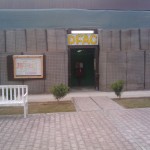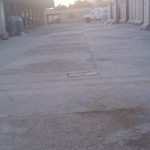The sealed envelope I received from UNIMA’s reception had my name on it as well as room number: 2b. That did not tell me anything. As we left the reception area, a woman greeted one of the UNDP colleagues and said that the Compound bar, called UNdercover -or secondary triage area, was still open for business. The bar opens three nights a week and Thursdays, being the last day of the working week, remain open until the last customer decides to leave. I later heard that this particular evening the bar ended activities at 6am.
I had a hard time opening the door of my room as I could not find any light around. The UNIMA room is a fully carpeted rectangle of 6×4 meters with a full-size bed, a nice and generous wooden work desk with a lamp, a stand-alone two-door 1.90-meter wooden wardrobe with drawers and hangers, satellite TV, wired Internet, AC, heater, two towels and two bars of soap, and a fridge with at least 20 bottles of water and one little milk carton -similar to those I pack for my son’s school lunch back in NY. The hand-wash sink is in one of the corners of the room but the shower and toilet are in a separate room directly connected to the main container. The room has one small window facing the narrow walk path outside but it is covered by an external wall and/or sandbags. So one never gets any natural light once inside.
Once I entered 2b, I sensed a lot of humidity in the air and the typical smell that comes with it. I soon discovered that about 1 meter (from the wall) of the carpet was completely wet, from the restroom wall all the way down to the bed. I had to tip-toe my way around to use the sink. I soon discovered that the toilet pipe was broken and should be closed all the time to void further damage. I planned to report this to UNIMA the following morning. Eventually, I had no choice but to switch rooms as the problem could not be fixed.

I woke up at 10:30am on Friday. I was really hungry. I now had to find my way to the DFAC. Every room has a colored map of the compound. I studied mine and got ready to head out. I read that the DFAC serves lunch from 11:30am to 1:30pm. So I had to wait a few minutes. I checked my email once again and realized that the connection speed was amazingly good, better than in most 5 stars hotels of many developing countries, and free! I then ventured out and somehow managed to get to the DFAC. I was not sure I could easily get back to my room though -as the compound is intentionally designed as a maze, for security reasons.
Compared to the US DFACs we frequented the previous days, UNAMI’s is pretty small. And no weapons are allowed. The food is of better quality (size matters!) and includes more international options. They also have great desserts but the coffee is below par. A few tables have been set up just outside the DFAC where one can sit and enjoy the weather as there is no roof or protection from mortar or rocket attacks. This area looks like a small town square to which most Compound maze paths eventually connect. Sitting here is great but one has to deal with the low-flying US helicopters which make a thundering noise.

UNDP has organized a mandatory security briefing for newcomers to Iraq at 3pm. This meant taking an official UN armored car and driving less than 1 kilometer to Diwan where UNDP and other agencies have set their offices in Baghdad. I soon discovered that, unlike all other UN agencies, UNDP staff are not allowed to drive any vehicles in Iraq. To go out we need to secure both a driver and a car. Since Friday is a holiday here, the regular UNDP driver had the day off. At any rate, I was told to be at the gate of the Compound at 2:30pm along with my PPE and radio that UNIMA had provided upon arrival.
As I was heading to the gate I ran into several of the colleagues that I had met back in November at the mandatory security training course (SAIT) held in Amman. Most of these young guys are PSDs. A few of them will be taken care of for the next few days. However, going to Diwan does not require PSD support. We did not either have to wear our PPEs which we loaded into the back of the SUV. I had a hard time opening and closing the doors of the armored vehicle as they were unexpectedly heavy.
The first thing one notices in the IZ is that every single road and building is surrounded by thick concrete walls which are 3 meters high, more or less. It is thus difficult to see anything around other than the innumerable checkpoints, plenty of cars and very few people walking in the streets. I was able to see a few beautiful houses in the area which, to my surprise, had no roof protection and showed no signs of being targeted. In this area, we can find Sadam’s Presidential Palace (now part of the US Embassy); large villas for Saddam’s family, friends and former Baath party loyalists; the Tomb of the Unknown Soldier; the Military History Museum; and a large park which hosts the well-known crossed sabers and parade route. At any rate, it took us 15 minutes to get to Diwan and had to only clear one checkpoint.
Later that evening, while having dinner at the DFAC in UNIMA, I asked one of my more veteran Arab colleagues why was the UN Compound called Tamimi. “And, by the way, what does Tamimi stand for”, I added. This time, I had previously checked on the Web. The answers I found there did not satisfy me. So I had to ask. Turns out Tamimi is the name of a large Saudi company founded by a Sheikh whose last name was, well, Tamimi. The company was apparently awarded the contract to build the Compound a few years ago. And the word Tamimi has no meaning whatsoever.
Back in my container room, as the evening progressed at a seemingly slow pace, I started to wonder why the UNdercover bar only opened 3 nights a week. I promptly understood why…
